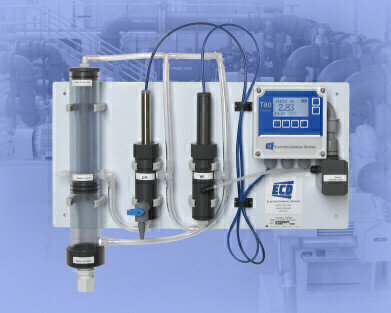Water/Wastewater
Dual Range Hydrogen Peroxide Analyser Suitable for Disinfection or Bleaching Processes
Sep 08 2016
With a versatile dual parameter measurement range capability, the advanced HP80 Hydrogen Peroxide Analyser from US-based Electro-Chemical Devices (ECD) is a highly flexible and reliable instrument designed to measure H2O2 in both the parts per million (ppm) range and the percent solution range to support a variety of process applications.
Process and plant engineers will find the HP80 Analyser is an easy-to-use measurement solution that’s ready to go right out of the box with a plumb-and-play design, which a single technician can set up in less than 15 minutes with no special tools. It’s a complete analyser system including an H2O2 sensor, a pH sensor, a constant head flow control device and transmitter with power supply all mounted on a PVC wall panel that’s ready to hang.
H2O2 is a colourless liquid that in high concentrations gives o? an irritating acidic odour. It is a strong oxidiser, stronger than either chlorine or chlorine dioxide. Hydrogen peroxide reacts very fast. It will then disintegrate into oxygen gas and water without the formation of harmful byproducts and also increases the amount of oxygen in water.
H2O2 is used by municipalities as an oxidizer to remove metals from raw well water sources. The pulp and paper industries extensively use H2O2 as a bleaching agent to give paper that crisp white look. Other uses include as a disinfectant in cooling towers and municipal wastewater treatment plants.
An e?ective bactericide, H2O2 does not form any harmful disinfection byproducts (DBP’s), as opposed to the typical chlorine products for drinking water and wastewater treatment that do. It decomposes naturally into oxygen and water and does not form a residual that has to be removed from the treated water before it is released to the environment.
The HP80 Analyser features amperometric H2O2 sensors. These amperometric sensors are manufactured with a gold cathode, a silver anode and a rugged microporous membrane.
The H2O2 sensors are smart sensors with their identity and calibration information stored internally. Communication between the T80 Transmitter and the H2O2 sensor is via MODBUS. The sensors are flow sensitive requiring a minimum flow rate of 0.5 ft/sec, above this flow rate, the reading is virtually independent of the flow rate.
A constant head flow control device (CFD) maintains the optimum flow rate moving past the sensor for sampling purposes. The CFD’s automatic flow control capability eliminates the need for pressure regulators and rotameters, which are required by many other H2O2 analysers, to reduce system maintenance and lifecycle operating costs. The minimum flow rate required by the CFD is 10 gal/hr, and the maximum flow rate is 80 gal/hr with the sample draining at atmospheric pressure.
The HP80’s H2O2 sensors feature a measurement range of 0 to 200 ppm (2000 ppm, 2%, 20% optional). The pH sensor has a range of 2 to 11 pH. Operating temperature range for these sensors is 0 to 45°C (32 to 113°F) with automatic temperature compensation for the H2O2 sensor.
An optional sensor auto clean configuration is available, which includes a solenoid actuated spray cleaner that provides either a 30 psi process water or air. The spray cleaner removes films from the sensor head, which over time can affect measurement accuracy. There is rarely a need for manual wiping of the sensor head by maintenance technicians with the spray clean configuration. The sensor’s maintenance requirement is typically to replace the electrolyte every six months and replace the membrane cap once a year.
Designed with ECD’s T80 Universal Transmitter, the HP80 Analyser includes a 128-x-64 pixel (2.75-x-1.5-inch) display. The display is black on grey with no backlight or blue on a white background with the LED backlight. The standard configuration features two 4-20 mA outputs, three alarm relays and a MODBUS RTU. The enclosure is rated to IP65 and weatherproof.
Digital Edition
AET 28.4 Oct/Nov 2024
November 2024
Gas Detection - Go from lagging to leading: why investment in gas detection makes sense Air Monitoring - Swirl and vortex meters will aid green hydrogen production - Beyond the Stack: Emi...
View all digital editions
Events
Dec 02 2024 London, UK
Dec 03 2024 Dusseldorf, Germany
Dec 11 2024 Shanghai, China
Jan 12 2025 Abu Dhabi, UAE
Jan 14 2025 Abu Dhabi, UAE













.jpg)





